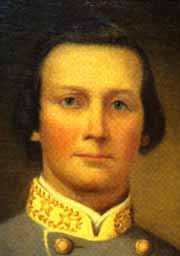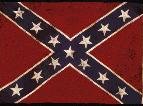|
South Carolina C.S.A.
|

|
|

|
South Carolina C.S.A. |
|
|
|
On of the most difficult parts of understanding the Battle for Atlanta is the lack of consensus concerning names. The men of the Sixteenth often refer to the Battle of Atlanta proper as Decatur. To those who attempt to study the southern units or the Army of Tennessee, involved in the defense of Atlanta, understanding the name game becomes a most time consuming part of your research. Scholars assume you have the intimate knowledge they possess and it can become extremely frustrating working with and learning the names of the minor actions. New Hope Church is called Dallas. I remain unclear about the action at Mcginnis Ferry or Calhoun, as it is called in some accounts. I certainly feel it was in connection with the attempt to cut the road to Calhoun by Sherman, but am unsure about other accounts and how they all fit into the big picture. This is a minor action and so little has been written about how it fits with Walker's moves on the fifteenth and sixteenth. I do believe that the fighting involving the Sixteenth takes place on the fourteenth and stands alone, even though Capers account does not fit well, with some post war accounts, particularly Union ones. (The complexities are legion for those who wish to examine the actions of regiments within the scope of the broader Atlanta campaign and certainly most of the limitations I have addressed are mine and mine alone. This seems to be a bit like the five blind men and the elephant and I am the most blind by far. I do not look forward to the exploration of the defense of the pontoon bridges after Nashville by the Gist Brigade and the Sixteenth.) After Dallas, the Gist Brigade first occupies a position on Pine or Pine Knot Mountain, not far from where General Polk is killed. Although never known as Pine Knot Mountain, men writing within the Sixteenth particularly those from D, G, and H Company refer to this position as Pine Knot Mountain. The writers who dominate the field today frequently refer to this line of defense as the Lost Mountain or Brushy Mountain Line. At Kennesaw Mountain, Gist Brigade and Walker’s Division occupy the right center of the line from the Confederate viewpoint. In the battle that is today referred to as Battle of Kennesaw Mountain the Gist’s Brigade is on the extreme left of the action on the Confederate right. This action involved the Union attack against Loring’s or Polk’s Corp. The Brigade occupied the right center or the position that was the least active in the battle. Action was also heavy on the other end of the line, and it is here, on the left, that perhaps the most famous moment in the Battle for Kennesaw Mountain takes place. In Cleburne’s front fire breaks out and threatens to engulf many Union wounded. Colonel William Martin of Govan’s Brigade mounts the works with a ramrod and a handkerchief and shouts to the enemy, "Come and remove your wounded, they are burning to death; we won’t fire a gun till you get them away…. Be Quick! The fighting stops, the fire is extinguished, Confederates help carry out the Union wounded and the men move quickly back to their positions and resume the deadly business of war. It is one of the finest moments of the War of Brothers. The fire, the heat, the muggy weather, punctuated by rain and mud and the Georgia summer humidity, life could not get much worse, unless you got wounded. There is much speculation as to why Sherman acted as he did at Kennesaw, certainly if he was concerned about his lack of press, as some have suggested, he corrected that problem. However, he also learned his lesson well, never again would he waste men the way he did in the action at Kennesaw. Once again, Walker’s Brigade is only lightly involved, dodging the bullet until another day. However, dodging the bullet at Kennesaw was a relative matter, at best. Kennesaw is a terrible time for all the units along that line. It is the harbinger of Petersburg and the First World War, like the battle at Dallas, the generals are learning to dig in and let the rifled musket do its work. Make the other man attack. The end result is a war of daily attrition, a battle of snipers, and that is where the Gist Brigade pays the price in front of Kennesaw. Never ending daily attrition, becomes the name of the game. You will find a rather eloquent expression of the cost in Captain Samuel Mckittrick’s letter in these pages and an interesting note or two concerning the evolution of war in General Capers reports. Shortly after the retreat from Kennesaw, Old Uncle Joe Johnston is relieved of command and Hood takes control. His first action is to go on the offensive in the Battle of Peachtree Creek. This action appears to hit Company D of the Sixteenth pretty hard. This is also the time that the Sixteenth receives the men from the Palmetto Light Artillery. General Capers reports, if he made any, have not been located by this writer but they would do little good as the Twenty-fourth was detached during this battle. Following this, the Sixteenth is involved in the Battle of Atlanta and General Walker is killed trying to find a way around the pond and obstructions on the Gist brigade front. Once again, there are few good accounts of the Sixteenth in this battle. Deadly time in the siege lines around Atlanta proper follows and then suddenly Sherman and his army vanish. Sherman has completely foxed Hood the race to Jonesboro begins. Hood places his army in the most dangerous position of the entire campaign at Jonesboro. Only fools luck and Ellison Capers and his men save at least a part of the army from complete disaster. It is certainly Capers finest hour and is one of the best fights in the entire Gist Brigade history. The Brigade picks up a new nickname as a result; they are called the "Pocketknife Brigade". The fall of Atlanta is followed by the retreat to Lovejoy and on to Palmetto. Finally a time of rest before the terrible Tennessee Campaign of 1864. For the student of the Sixteenth, the best widely available documents are those of Ellison Capers. His reports cover the campaign until the relief of Johnston. His actions at Jonesboro where his pocket knife brigade is able to keep the union army from rolling up the much smaller force opposing them, is also well documented. However, August 31, 1864 is not covered. As mentioned before, this is one of the most disastrous moments of Hood’s disastrous command, he looses Atlanta and very nearly his entire army with it. Violating every known military precept, he manages to divide his command into three pieces, after having lost track of Sherman’s army completely. His assessment of the battle and conditions around him would never be worse, at least until he gets to Franklin. On that very bad day at Jonesboro, Ellison Capers and the Gist Brigade is the best ray of sunshine to be found. Like Franklin, it is a moment to be extremely proud of. Never did men act in a more devoted manner, than Hood’s men did at Franklin and Nashville, never were the Confederates slicker and smarter and tougher than Ellison Capers and the men of the Gist Brigade at Jonesboro. At this time, I do not have access to Capers thoughts or any reports on the Battle at Peachtree Creek or Atlanta, except obliquely. Nor do I have any other written report of the actions of the Sixteenth or the Gist Brigade for this period of time that John Bell Hood commanded the Army of Tennessee in and around Atlanta. These blanks I will fill in slowly as I am sure of the information and material I use. The Twenty-fourth was not with the Sixteenth and the rest of the Gist Brigade at the Battle of Peachtree Creek, so Caper’s report for that battle would provide little useful information, relevant to the Sixteenth. Above you will find links to Caper’s Reports for the Hundred Days of Atlanta. They will provide much in the way of helpful information to the student of the unit. The single best source of information remains Jones book on the Twenty-fourth; everyone should have a copy. |

|
|

|